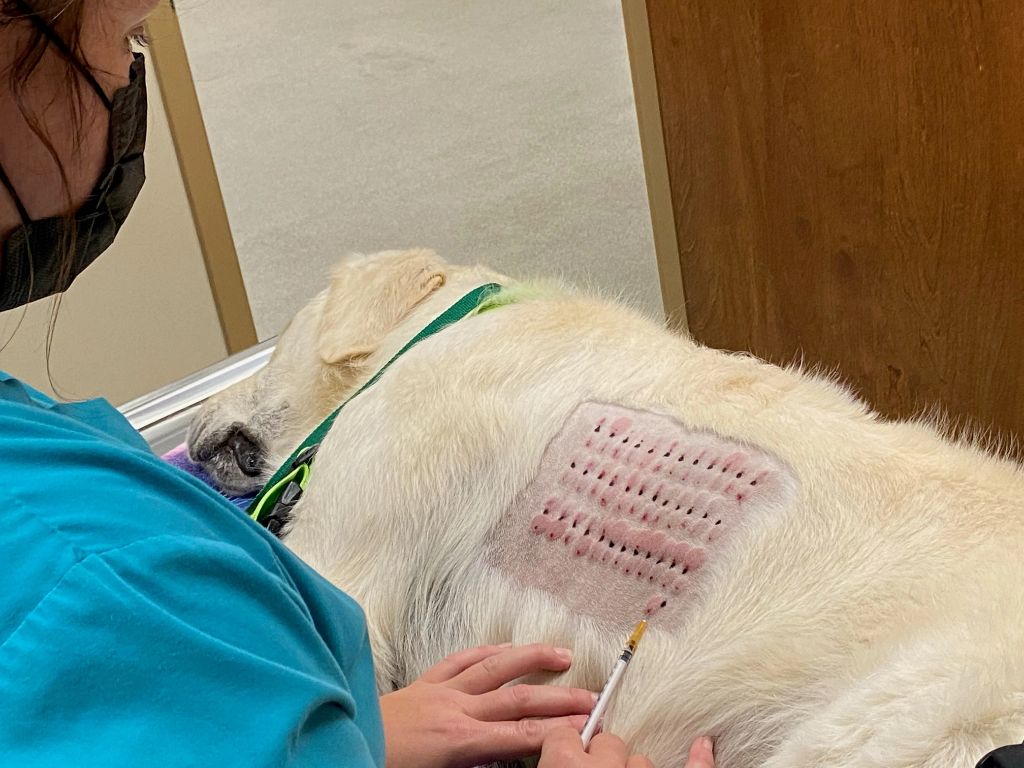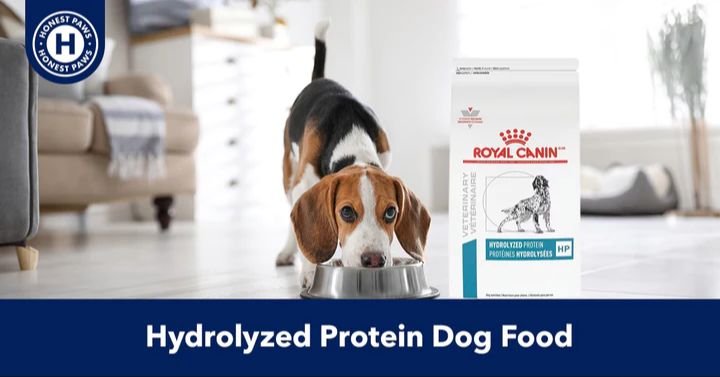What Are Grass Allergies in Dogs?
Grass allergies, also known as pollen-associated seasonal allergic dermatitis, are common allergies in dogs that are caused by an overreaction of the immune system to grass pollens in the environment (PetMD). When dogs with grass allergies come into contact with grass pollen, usually through inhalation or contact with their paws, they can develop symptoms like itchy skin, ear infections, wheezing, sneezing, and skin irritation.
The most common grass allergen sources for dogs include ryegrass, Timothy grass, Bermuda grass, Johnson grass, and Kentucky bluegrass (WagWalking). The allergy is an immune system overreaction to proteins found in the pollen of these grasses. Upon exposure, the dog’s immune system identifies the pollen proteins as a foreign invader and releases antibodies to attack them. This leads to inflammation and the development of allergy symptoms.
Symptoms typically involve skin irritation and itchiness. Affected dogs may constantly lick, bite, chew or scratch at their paws, belly, armpits or ears. Over time, this can lead to hair loss, open sores and skin infections. Dogs may also exhibit sneezing, watery eyes, coughing, and wheezing if they inhale the allergens. Symptoms tend to worsen during peak pollen seasons in spring, summer, and fall when grasses are actively pollinating.
Common Grass Allergens
There are several types of grass that dogs may develop allergies to:
- Bermuda grass – A warm season grass common in lawns across the southern United States. Bermuda grass pollen is a very common allergen in dogs (source).
- Kentucky Bluegrass – A cool season grass often used in lawns and athletic fields. The pollen can trigger allergic reactions in dogs (source).
- Orchard grass – A bunch-type grass grown as hay for livestock. The pollen is airborne and dogs may be allergic (source).
- Ryegrass – Often used for lawns, pastures, and hay. Dogs may be allergic to perennial and annual ryegrass pollens (source).
- Timothy grass – A common cool season hay grass. The pollen can act as an allergen and trigger symptoms in dogs (source).
These grasses release pollen that dogs inhale or come into contact with on their skin and paws, potentially causing an allergic reaction.
Diagnosing Grass Allergies
Diagnosing grass allergies in dogs typically involves testing by a veterinarian. There are a few main diagnostic methods:

Skin testing. This is considered the “gold standard” for diagnosing allergies in dogs. Small amounts of suspected allergens are injected under the skin and the area is observed for reactions like redness or swelling. Skin testing provides the most accurate results (Source).
Blood tests. Blood samples can be analyzed to measure a dog’s allergen-specific IgE levels. Higher levels indicate an allergy. However, blood tests are not as accurate as skin testing (Source).
Elimination diet. Feeding your dog a hypoallergenic diet containing novel protein and carbohydrate sources can help determine if food allergies are contributing to symptoms. If the diet improves symptoms, food allergies may be present (Source).
Treatment Options
There are several treatment options available for dogs with grass allergies:
Allergen avoidance – This involves keeping your dog off grass as much as possible, especially during times when pollen counts are high. Wipe your dog’s paws and underside when coming inside. You can also use booties to protect their paws when outdoors.
Antihistamines – Your vet may prescribe antihistamines like Benadryl or Zyrtec to help relieve allergy symptoms. These work by blocking histamine release in the body. Make sure to follow dosage guidelines carefully.
Immunotherapy – This involves administering allergen extracts to your dog in gradually increasing amounts over time. This helps desensitize the immune system. Immunotherapy can be given as allergy shots or sublingual drops. According to WagWalking, immunotherapy is 70-80% effective for environmental allergies.
Baths and wipes – Frequent bathing using a gentle shampoo can help rinse off allergens. Hypoallergenic pet wipes can also help remove allergens from your dog’s coat and paws between baths.
Managing Grass Allergies
Managing your dog’s grass allergies is important to reduce allergy symptoms and keep your dog comfortable. Some tips for managing grass allergies are:

Keeping dogs off grass as much as possible during high pollen seasons can help reduce exposure to allergens. Walk dogs on pavement or woodchips instead of grassy areas when allergies are bad.
Wipe off your dog’s paws after going outside to remove any pollen or allergens they may have picked up on their feet from the grass. Use a damp washcloth or pet wipes to gently clean between paw pads.
Bathe dogs regularly using a veterinarian recommended hypoallergenic shampoo to wash away allergens from the coat and skin. Bathe at least once a week or as recommended when allergies are inflamed to remove allergens (https://www.petmd.com/dog/conditions/skin/can-dogs-be-allergic-grass). Frequent bathing is an important way to manage grass allergies.
Dietary Considerations
Allergies in dogs are often triggered by proteins in food. For dogs with grass allergies, changing to an appropriate diet can help reduce allergy symptoms and flare ups. Two dietary approaches that may help are hydrolyzed protein diets and limited ingredient diets.
Hydrolyzed protein diets break down proteins into smaller molecules so they are less likely to trigger an immune response. According to the NCBI, hydrolyzed protein diets “have been proven successful in diagnosing and treating adverse food reactions in dogs.” 1 Top hydrolyzed brands like Royal Canin Veterinary Diet and Purina Pro Plan Veterinary Diets use hydrolyzed soy or hydrolyzed collagen as the protein source.

Limited ingredient diets contain fewer ingredients and use novel or unique protein and carbohydrate sources like duck, salmon, or pea. This reduces the likelihood of allergens. Studies show dogs with allergies improve on limited ingredient diets. 2 Some top limited ingredient dog food brands are Natural Balance, Nutro, and Wellness Simple.
Work closely with your veterinarian to find the right diet for your dog’s grass allergy. They can recommend an appropriate prescription or over-the-counter elimination diet to pinpoint problem ingredients. With the right diet, you may see a reduction in allergy symptoms like itching, ear infections, and skin irritations.
Lifestyle Changes
Making some lifestyle changes can help minimize your dog’s exposure to grass allergens and reduce allergy symptoms. Here are some tips:
- Avoid letting your dog play or walk in grassy areas as much as possible, especially when pollen counts are high. Stick to paved areas when outside.
- Wipe your dog’s paws with a damp towel after walks to remove any pollen or allergens they may have picked up on their feet.
- Have your dog wear booties when going outside. This creates a barrier between their paws and the grass.
Making these simple changes can greatly reduce the amount of grass pollen your dog comes into contact with. Consult with your veterinarian for other lifestyle recommendations to manage your dog’s grass allergies.
Prevention
There are a couple ways to help prevent the development of grass allergies in dogs. One is through breed selection. Certain breeds like Labrador Retrievers, Golden Retrievers, and German Shepherds are more prone to allergies and sensitivities. Choosing a breed with a lower likelihood of allergies can help prevent issues.

Another prevention method is early exposure. Introducing dogs to grass and outdoor environments starting as puppies may help avoid allergies. According to PetMD, gradually exposing pups to grass and pollen starting around 4-6 months old, before their immune system fully develops, can help prevent sensitivity. Take puppies outside frequently and let them experience different grasses and environments in a controlled, positive way.
Prognosis
The prognosis for dogs with grass allergies is generally positive, as it is a manageable chronic condition. With proper treatment and management, most dogs can live comfortably with grass allergies. However, it is a lifelong condition that requires continued care. Quality of life is an important consideration, as allergies can be frustrating and uncomfortable for dogs. With medications, lifestyle changes, and prevention strategies, dogs with grass allergies can have a good quality of life. But severe cases may require intensive long-term treatment that can impact quality of life. Consulting a veterinarian helps determine if management strategies are maintaining a good quality of life or if additional interventions are needed. Overall, the prognosis is good but grass allergies do require an ongoing commitment to treatment and lifestyle adjustments.
When to See a Vet
If your dog is exhibiting any of the following symptoms, you should make an appointment with your veterinarian:
- Excessive or persistent scratching, biting, licking, or chewing at their paws, belly, or other parts of their body [1]
- Significant hair loss or abnormal bald patches on the belly or paws [2]
- Open sores, rashes, or hives appearing on the skin
- Swelling around the paws, muzzle, or eyes
- Frequent ear infections
- Vomiting or diarrhea that lasts more than a day or two
- Sneezing, coughing, wheezing, or other respiratory issues
- Loss of appetite or lethargy
A vet can help diagnose the underlying cause and severity of your dog’s allergies through tests and examinations. Early treatment is key to relieve discomfort and prevent secondary infections caused by excessive scratching and irritation.
